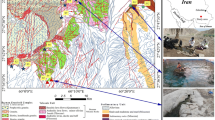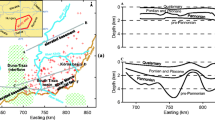Abstract
The groundwater of major karst systems and submarine springs in the coastal limestone aquifer of Syria has been investigated using chemical and isotopic techniques. The δ18O values of groundwater range from −6.8 to −5.05‰, while those for submarine springs vary from −6.34 to +1.08‰ (eastern Mediterranean seawater samples have a mean of +1.7‰). Groundwater originates from the direct infiltration of atmospheric water. Stable isotopes show that the elevation of the recharge zones feeding the Banyas area (400–600 m a.s.l.) is higher than that feeding the Amrit area (100–300 m a.s.l.). The 18Oextracted (18O content of the seawater contribution) for the major submarine springs suggests a mean recharge area elevation of 600–700 m a.s.l., and lower than 400 m a.s.l. for the spring close to Amrit. Based on the measured velocity and the percentage of fresh water at the submarine springs outlet, the estimated discharge rate is 350 million m3/year. The tritium concentrations in groundwater (1.6–5.9 TU) are low and very close to the current rainfall values (2.9–5.6 TU). Adopting a model with exponential time distribution, the mean turnover time of groundwater in the Al-sen spring was evaluated to be 60 years. A value of about 3.7 billion m3 was obtained for the maximum groundwater reservoir size.
Résumé
L’eau souterraine des principaux systèmes karstiques et sources sous-marines de l’aquifère calcaire côtier en Syrie a été étudiée grâce à des techniques chimiques et isotopiques. Les valeurs de δ18O sont comprises entre -6.8 et -5.05‰ pour l’eau souterraine, alors que celles des sources sous-marines varient entre -6.34 et +1.08‰ (les échantillons d’eau de mer de l’Est de la Méditerranée présentent une moyenne de +1.7‰). L’eau souterraine provient de l’infiltration directe de la pluie. L’étude des isotopes stables montre que l’altitude des zones de recharge alimentant la région de Banyas (400–600m au dessus du niveau moyen de la mer, a.s.l) est plus élevée que celle de la zone alimentant la région d’Amrit (100-300m a.s.l). L’étude du 18O extracted (la teneur en 18O de la contribution de l’eau de mer) suggère, pour les principales sources sous-marines, une zone de recharge d’altitude moyenne de l’ordre de 600–700m a.s.l et inférieure à 400m pour la source proche d’Amrit. A partir de la vitesse mesurée et du pourcentage d’eau douce à la sortie des sources sous-marines, le débit est estimé à 350 million m3/an. Les concentrations en tritium dans l’eau souterraine (1.6-5.9 UT) sont basses et très proches de celles de la pluie actuelle (2.9-5.6 UT). A partir d’un modèle de distribution exponentielle dans le temps, la durée moyenne de renouvellement de l’eau souterraine pour la source de Al-sen a été évaluée à 60 ans. La taille maximum du réservoir d’eau souterraine a pu être estimée à environ 3.7 billion m3.
Resumen
Se ha investigado el agua subterránea de sistemas kársticos principales y manantiales submarinos en el acuífero costero de calizas de Siria usando técnicas químicas e isotópicas. Los valores δ18O de agua subterránea varían de -6.8 a -5.05‰, mientras que los valores en manantiales submarinos varían de -6.34 a +1.08‰ (las muestras de agua de mar del Mediterráneo tienen una media de + 1.7‰). El agua subterránea se deriva de la infiltración directa de agua atmosférica. Los isótopos estables muestran que zonas de recarga que alimentan el área Banyas (400-600 m.s.n.m.) se encuentran a mayor altura que la zona de recarga que alimenta el área Amrit (100-300 m.s.n.m.). El valor 18Oextraido (contenido 18O de la contribución de agua de mar) para los manantiales submarinos principales sugiere una elevación media para el área de recarga de 600-700 m.s.n.m. y menor que 400 m.s.n.m. para el manantial cercano a Amrit. En base a la medición de velocidad y el porcentaje de agua fresca en la desembocadura de los manantiales submarinos se estimó una tasa de recarga de 350 millones m3/año. Las concentraciones de tritio en agua subterránea (1.6-5.9 UT) son bajas y muy cercanas a los valores de lluvia actual (2.9-5.6 UT). Se evaluó el tiempo de retorno del agua subterránea en el manantial Al-sen adoptando un modelo con distribución de tiempo exponencial obteniendo un valor de 60 años. Se obtuvo un valor de aproximadamente 3.7 billones de m3 para el tamaño máximo del reservorio de aguas subterráneas.













Similar content being viewed by others
References
Abou-Zakhem B (2000) Environmental isotopes study of the aquifer system in the coastal area, AECS-G FRSR 212, Atomic Energy Commission of Syria, Damascus, p 58
Ayoub G, Khoury R, Ghannam J, Acra A, Hamdar B (2002) Exploitation of submarine springs in Lebanon: assessment of potential. J Water Supply: Res Technol, AQUA, 51.1
Bakalowicz M (1979) Contribution de le géochimie des eaux à la connaissance de l’aquifère karstique et de la karstification. (Contribution of water geochemistry to the knowledge of karst aquifer and karst processes). PhD Thesis, P. et M. Curie Paris-6, Paris, p 269
Bakalowicz M (1994) Water geochemistry: water quality and dynamics. In: Groundwater ecology, Elsevier, Amsterdam, pp 97–127
Clark ID, Fritz P (1997) Environmental isotopes in hydrogeology. Lewis, New York, p 311
Craig H (1961) Isotopic variations in meteoric waters. Science 133:1702
Dansgaard W (1964) Stable isotopes in precipitation. Tellus 16:436
Drever JI (1997) The geochemistry of natural water: surface and groundwater, environments, 3rd edn. Prentice Hall, Englewood Cliffs, NJ, p 436
Dubertret L (1962) Carte géologique du Liban; Syrie et bordure des pays voisins 1/100,000, Muséum National D’Histoire naturelle, Paris, notes et mémoires sur le Moyen- Orient, T. VIII (Geological map of Lebanon; Syria and the borders of nearby countries 1/100,000, National Museum of natural history, Paris, notes and memories on the Middle-East, T VIII). International Stratigraphy lexicon, vol. III, F.10c. CNRS, Paris
Florkozski T (1981) Low-level tritium assay in water samples by electrolytic enrichment and liquid-scintillation counting in the IAEA laboratory. In: Proceedings of the International Symposium on Methods of Low-Level Counting and Spectrometry, IAEA-SM-252/63, IAEA, Vienna, p 558
Fontes JC, Gonfiantini R (1970) Composition isotopique et origine de la vapeur d”eaux atmosphérique dans la région du lac Léman. (Isotopic composition and origin of the atmospheric steam in the area of Lake Leman). Earth Planet Sci Lett 7:325–329
Gat JR (1980) The isotopes of hydrogen and oxygen in precipitation. In: Fritz P, Fontes J-ch (eds) Handbook of environmental isotope geochemistry, vol. 1, The terrestrial environmental. Elsevier, Amsterdam, pp 21–48
Gat JR, Carmi I (1970) Evolution of the isotopic composition of atmospheric water in the Mediterranean Sea Area. J Geophys Res 75:3039
Ghannam J, George M, Ayoub G, Acra A (1998) A profile of the submarine springs in Lebanon as a potential water resource. Water Int 23:278–286
Gonfiantini R (1986) Environmental isotopes in lake studies. In: Fritz P, Fontes J-ch (eds) Handbook of environmental isotope geochemistry, vol. 1, The terrestrial environmental. Elsevier, Amsterdam, pp 113–168
Gruvel A (1930) Quelques sources sous-marines observées sur les cotes Libano Syriennes (Some submarine springs observed on the Libano-Syrian coast), vol 191. Comptes-rendus de l’ Academic des Sciences, Paris
Hakim B (1985) Recherches hydrologiques et hydrochimiques sur quelques karsts Méditerranéens Liban, Syrie et Maroc (Hydrological and hydrochemical research on some Mediterranean karsts of Lebanon, Syria and Marocco). University of Lebanon, Beirut, p 701
IBG/DHV (2000) Project of supplying part of the water demand of Damascus city and its countryside from the Syrian coastal area water surplus, Hydrogeological investigation, NR.1, Phase 1-first stage, Damascus water supply and sewerage authority, Damascus, Syrian Arab Republic
International Atomic Energy Agency (1992) Statistical treatment of data on environmental isotopes in precipitation; Tech. Rep. Series No. 331, IAEA, Vienna
Irie M, Al Assad A (2002) Basic study of submarine springs in Bassiya Gulf, Ministry of Irrigation, Water Research Center. Japan Overseas Cooperation Volunteers, Damascus, p 82
Kareh RP (1966) The submarine springs of Chekka: exploitation of a confined karstic aquifer discharging into the sea. MSc. Thesis, American University of Beirut, Lebanon
Kattan Z (1997) Chemical and environmental isotope study of precipitation in Syria. J Arid Environ 35:601–615
Lucas LL, Unterweger MP (2000) Comprehensive review and critical evolution of the half-life of tritium. J Res Natl Stand Techno 105(4):541–549
Maloszewski P, Zuber A (1996) Lumped parameter models for the interpretation of environmental tracer data. In: Manual on mathematical models in isotope hydrology. IAEA, Vienna, pp 9–58
Moullard L, Mijatovic B, Kareh RP, Massad B (1967) Exploitation d’ une nappe Karstique captive a exutoires sous-marins, problèmes poses et solution adoptée, cote libanaise (Exploitation of confined karst aquifer with discharge underwater: problems installations and adopted solution) vol 73. In: Hydrology of fractured rocks (I-Proc. Symposium Dubrovnic), Assoc. Int. Hydrol. Sci., Gentbrugge, pp 273–250
Plagnes V (2000) Structure et fonctionnement des aquifères karstiques: caractérisation par la géochimie des eaux. (Structure and function of the karstic aquifers: characterization by the geochemistry of water). Documents du BRGM 294, BRGM, Orléans, pp 376
Ponikarov VO (1966) The geology of Syria, Explanatory notes on the map of Syria, Scale 1:500 000, Part II. Mineral deposits and underground water resource, Technoexport, Moscow, pp 120
Selkhozpromexport (1979) Hydrogeological and hydrological surveys and investigation in four areas of Syrian Arab Republic, coastal area, vol. II, Hydrology. Georgian State Institute for Design of Water Resources Development Projects., Tbilisi, USSR, pp 173
UNESCO (2004) Submarine groundwater discharge. Management implications, measurements and effects. IHP-VI, Series on Groundwater No. 5, ICO Manuals and Guides No. 44, UNESCO, Paris
Yurtsever Y (1979) Environmental isotopes as a tool in hydrogeological investigations of southern karst regions of Turkey. Int. Seminar on Karst Hydrogeology, Antalya, October 1979, pp 269–293
Zuber A (1986) Mathematical models for the interpretation of environmental radioisotopes in groundwater systems, chap 1. In: Fritz P, Fontes J Ch (eds) Handbook of environmental isotope geochemistry, vol. 2. Elsevier, Amsterdam, pp 1–59
Acknowledgements
The author would like to thank I. Othman, Director General of AECS for use of their facilities during this study. I am also grateful to M. Geyh, M. Bakalowicz, W.R. Agha and S. Rammah for their helpful comments and useful discussion. The author thanks R. Naser, Head of the Geology Department at the AECS, and the staff of the laboratories for their cooperation in performing the isotopic and chemical analyses. The work was financially supported in part by the Supreme Council of Sciences (Res-Pro, No. 9. /2001).
Author information
Authors and Affiliations
Corresponding author
Rights and permissions
About this article
Cite this article
Charideh, A., Rahman, A. Environmental isotopic and hydrochemical study of water in the karst aquifer and submarine springs of the Syrian coast. Hydrogeol J 15, 351–364 (2007). https://doi.org/10.1007/s10040-006-0072-x
Received:
Accepted:
Published:
Issue Date:
DOI: https://doi.org/10.1007/s10040-006-0072-x




